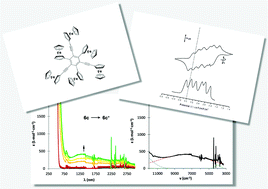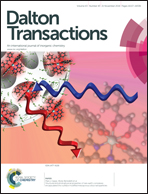1,3,5-Triferrocenyl-2,4,6-tris(ethynylferrocenyl)-benzene – a new member of the family of multiferrocenyl-functionalized cyclic systems†‡
Abstract
The consecutive synthesis of 1,3,5-triferrocenyl-2,4,6-tris(ethynylferrocenyl)benzene (6c) is described using 1,3,5-Cl3-2,4,6-I3-C6 (2) as starting compound. Subsequent Sonogashira C,C cross-coupling of 2 with FcC![[triple bond, length as m-dash]](https://www.rsc.org/images/entities/char_e002.gif) CH (3) in the molar ratio of 1 : 4 afforded solely 1,3,5-Cl3-2,4,6-(FcC
CH (3) in the molar ratio of 1 : 4 afforded solely 1,3,5-Cl3-2,4,6-(FcC![[triple bond, length as m-dash]](https://www.rsc.org/images/entities/char_e002.gif) C)3-C6 (4c) (Fc = Fe(η5-C5H4)(η5-C5H5)). However, when 2 is reacted with 3 in a 1 : 3 ratio a mixture of 1,3,5-Cl3-2-(FcC
C)3-C6 (4c) (Fc = Fe(η5-C5H4)(η5-C5H5)). However, when 2 is reacted with 3 in a 1 : 3 ratio a mixture of 1,3,5-Cl3-2-(FcC![[triple bond, length as m-dash]](https://www.rsc.org/images/entities/char_e002.gif) C)-4,6-I2-C6 (4a) and 1,3,5-Cl3-2,4-(FcC
C)-4,6-I2-C6 (4a) and 1,3,5-Cl3-2,4-(FcC![[triple bond, length as m-dash]](https://www.rsc.org/images/entities/char_e002.gif) C)2-6-I-C6 (4b) is obtained. Negishi C,C cross-coupling of 4c with FcZnCl (5) in the presence of catalytic amounts of [Pd(CH2C(CH3)2P(tC4H9)2)(μ-Cl)]2 gave 1,3-Cl2-5-Fc-2,4,6-(FcC
C)2-6-I-C6 (4b) is obtained. Negishi C,C cross-coupling of 4c with FcZnCl (5) in the presence of catalytic amounts of [Pd(CH2C(CH3)2P(tC4H9)2)(μ-Cl)]2 gave 1,3-Cl2-5-Fc-2,4,6-(FcC![[triple bond, length as m-dash]](https://www.rsc.org/images/entities/char_e002.gif) C)3-C6 (6a), 1-Cl-3,5-Fc2-2,4,6-(FcC
C)3-C6 (6a), 1-Cl-3,5-Fc2-2,4,6-(FcC![[triple bond, length as m-dash]](https://www.rsc.org/images/entities/char_e002.gif) C)3-C6 (6b) and 1,3,5-Fc3-2,4,6-(FcC
C)3-C6 (6b) and 1,3,5-Fc3-2,4,6-(FcC![[triple bond, length as m-dash]](https://www.rsc.org/images/entities/char_e002.gif) C)3-C6 (6c) of which 6b is the main product. Column chromatography allowed the separation of these organometallic species. The structures of 4a,b and 6a in the solid state were determined by single crystal X-ray diffractometry showing a π–π interacting dimer (4b) and a complex π–π pattern for 6a. The electrochemical properties of 4a–c and 6a–c were studied by cyclic voltammetry (=CV) and square wave voltammetry (=SWV). It was found that the FcC
C)3-C6 (6c) of which 6b is the main product. Column chromatography allowed the separation of these organometallic species. The structures of 4a,b and 6a in the solid state were determined by single crystal X-ray diffractometry showing a π–π interacting dimer (4b) and a complex π–π pattern for 6a. The electrochemical properties of 4a–c and 6a–c were studied by cyclic voltammetry (=CV) and square wave voltammetry (=SWV). It was found that the FcC![[triple bond, length as m-dash]](https://www.rsc.org/images/entities/char_e002.gif) C-substituted benzenes 4a–c show only one reversible redox event, indicating a simultaneous oxidation of all ferrocenyl units, whereby 4c is most difficult to oxidise (4a, E°′1 = 190, ΔEp = 71; 4b, E°′1 = 195, ΔEp = 59; 4c, E°′1 = 390, ΔEp = 59 mV). In case of 4c, the oxidation states 4cn+ (n = 2, 3) are destabilised by the partial negative charge of the electronegative chlorine atoms, which compensates the repulsive electrostatic Fc+–Fc+ interactions with attractive electrostatic Fc+–Clδ− interactions. When ferrocenyl units are directly attached to the benzene C6 core, organometallic 6a shows three, 6b five and 6c six separated reversible waves highlighting that the Fc units can separately be oxidised. UV-Vis/NIR spectroscopy allowed to determine IVCT absorptions (=Inter Valence Charge Transfer) for 6cn+ (n = 1, 2) (n = 1: νmax = 7860 cm−1, εmax = 405 L mol−1 cm−1, Δν1/2 = 7070 cm−1; n = 2: νmax = 9070 cm−1, εmax = 620 L mol−1 cm−1, Δν1/2 = 8010 cm−1) classifying these mixed-valent species as weakly coupled class II systems according to Robin and Day, while for 6a,b only LMCT transitions (=ligand to metal charge transfer) could be detected.
C-substituted benzenes 4a–c show only one reversible redox event, indicating a simultaneous oxidation of all ferrocenyl units, whereby 4c is most difficult to oxidise (4a, E°′1 = 190, ΔEp = 71; 4b, E°′1 = 195, ΔEp = 59; 4c, E°′1 = 390, ΔEp = 59 mV). In case of 4c, the oxidation states 4cn+ (n = 2, 3) are destabilised by the partial negative charge of the electronegative chlorine atoms, which compensates the repulsive electrostatic Fc+–Fc+ interactions with attractive electrostatic Fc+–Clδ− interactions. When ferrocenyl units are directly attached to the benzene C6 core, organometallic 6a shows three, 6b five and 6c six separated reversible waves highlighting that the Fc units can separately be oxidised. UV-Vis/NIR spectroscopy allowed to determine IVCT absorptions (=Inter Valence Charge Transfer) for 6cn+ (n = 1, 2) (n = 1: νmax = 7860 cm−1, εmax = 405 L mol−1 cm−1, Δν1/2 = 7070 cm−1; n = 2: νmax = 9070 cm−1, εmax = 620 L mol−1 cm−1, Δν1/2 = 8010 cm−1) classifying these mixed-valent species as weakly coupled class II systems according to Robin and Day, while for 6a,b only LMCT transitions (=ligand to metal charge transfer) could be detected.


 Please wait while we load your content...
Please wait while we load your content...